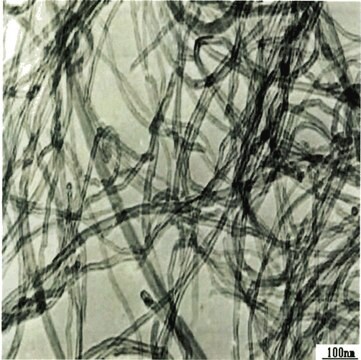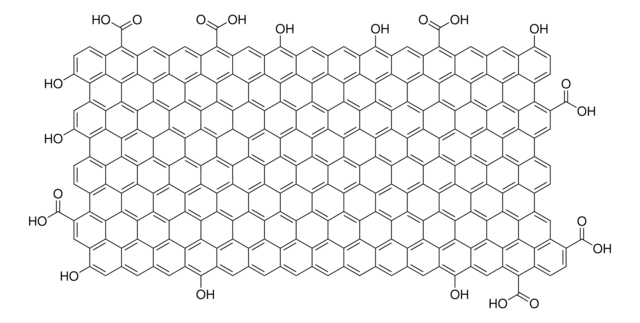750522
Carbon nanotube, single-walled
98% (Semiconducting), avg. no. of layers, 1
Sinonimo/i:
SWCNT
About This Item
Prodotti consigliati
Livello qualitativo
Saggio
2% (Metallic)
98% (Semiconducting)
Stato
solid
Caratteristiche
avg. no. of layers 1
Produttore/marchio commerciale
NanoIntegris, Inc.
Lunghezza
0.3-5 μm
Diametro
1.2-1.7 nm
Punto di fusione
3652-3697 °C (lit.)
Densità
1.7-1.9 g/cm3 at 25 °C (lit.)
Stringa SMILE
[C]
InChI
OKTJSMMVPCPJKN-UHFFFAOYSA-N
Cerchi prodotti simili? Visita Guida al confronto tra prodotti
Categorie correlate
Descrizione generale
Applicazioni
- Electronics
- Sensors
- Composites
- Energy Storage
- Study of Life Science systems
Nota sulla preparazione
Note legali
Codice della classe di stoccaggio
11 - Combustible Solids
Classe di pericolosità dell'acqua (WGK)
WGK 3
Punto d’infiammabilità (°F)
Not applicable
Punto d’infiammabilità (°C)
Not applicable
Elenchi normativi
Forniamo informazioni su eventuali restrizioni prevalentemente per i prodotti chimici. Per altre tipologie di prodotto siamo in grado di fornire soltanto informazioni limitate. Nessuna segnalazione significa che nessuno dei componenti è citato in un elenco. È dovere dell’utilizzatore assicurarsi che il prodotto venga impiegato in maniera sicura e a norme di legge.
EU REACH Annex XVII (Restriction List)
Scegli una delle versioni più recenti:
Possiedi già questo prodotto?
I documenti relativi ai prodotti acquistati recentemente sono disponibili nell’Archivio dei documenti.
I clienti hanno visto anche
Articoli
Electronic and Biomedical Applications of High-Purity Single-Walled Nanotubes (SWNTs)
Carbon nanomaterials (CNMs), such as single-walled carbon nanotubes (SWCNTs), multi-walled carbon nanotubes (MWCNTs), and graphene (Figure 1), have diverse commercial applications including lighter and stronger composite materials, improved energy storage devices, more sensitive sensors, and smaller transistors.
Boron nitride nanotubes (BNNT) are close structural analogs of carbon nanotubes (CNT), which are high aspect ratio nanotubular material, where carbon atoms are alternately substituted by nitrogen and boron atoms.
Dr. Xiang’s and Maruyama’s review presents the most recent research activities on 1D vdWHs, including the candidate materials, the synthetic techniques, and characterization methods. The optoelectronic applications are discussed in detail for different constructions of the 1D vdWHs-based devices (FETs, sensors, LEDs, photovoltaic devices, and light detection). Some challenges and perspectives for future development and applications of 1D vdWHs are also proposed to conclude the review.
Protocolli
Single-Walled Carbon Nanotubes synthesized by the Super-Growth Method & their properties & applications, including dispersing SGCNTs, SGCNT-polymer composites & SGCNT-metal composites are discussed.
Global Trade Item Number
| SKU | GTIN |
|---|---|
| 750522-1MG | 4061826688663 |
Il team dei nostri ricercatori vanta grande esperienza in tutte le aree della ricerca quali Life Science, scienza dei materiali, sintesi chimica, cromatografia, discipline analitiche, ecc..
Contatta l'Assistenza Tecnica.




